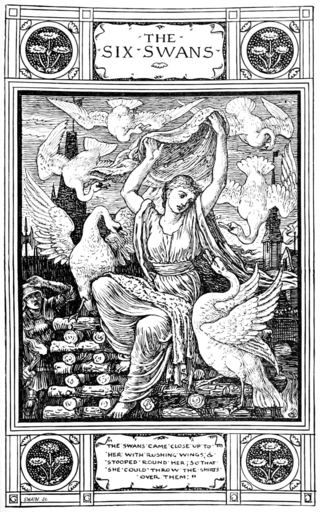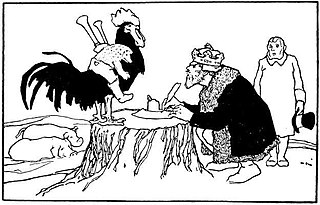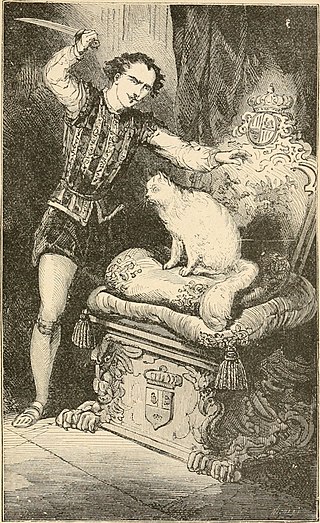
"Snow White" is a German fairy tale, first written down in the early 19th century. The Brothers Grimm published it in 1812 in the first edition of their collection Grimms' Fairy Tales, numbered as Tale 53. The original German title was Sneewittchen; the modern spelling is Schneewittchen. The Grimms completed their final revision of the story in 1854, which can be found in the 1857 version of Grimms' Fairy Tales.

"The Six Swans" is a German fairy tale collected by the Brothers Grimm in Grimm's Fairy Tales in 1812. It is of Aarne–Thompson type 451, commonly found throughout Europe. Other tales of this type include The Seven Ravens, The Twelve Wild Ducks, Udea and her Seven Brothers, The Wild Swans, and The Twelve Brothers. Andrew Lang included a variant of the tale in The Yellow Fairy Book.

The Golden Bird is a fairy tale collected by the Brothers Grimm about the pursuit of a golden bird by a gardener's three sons.

"Hans My Hedgehog" is a German fairy tale collected by the Brothers Grimm. The tale was translated as Jack My Hedgehog by Andrew Lang and published in The Green Fairy Book. It is of Aarne-Thompson type 441.
"Cap-o'-Rushes" is an English fairy tale published by Joseph Jacobs in English Fairy Tales.

The Story of Pretty Goldilocks or The Beauty with Golden Hair is a French literary fairy tale written by Madame d'Aulnoy. Andrew Lang included it in The Blue Fairy Book.

The Two Brothers is a German fairy tale collected by the Brothers Grimm, tale number 60. It is Aarne-Thompson type 303, "The Blood Brothers", with an initial episode of type 567, "The Magic Bird Heart". A similar story, of Sicilian origin, was also collected by author and folklorist Andrew Lang in The Pink Fairy Book.

The White Cat is a French literary fairytale written by Madame d'Aulnoy and published in 1698. Andrew Lang included it in The Blue Fairy Book.
"The Three Little Birds" is a German fairy tale collected by the Brothers Grimm, tale number 96. The story is originally written in Low German. It is Aarne-Thompson type 707, the dancing water, the singing apple, and the speaking bird. The story resembles Ancilotto, King of Provino, by Giovanni Francesco Straparola, and The Sisters Envious of Their Cadette, the story of the 756th night of the Arabian Nights.

"Donkey Cabbages" is a German fairy tale collected by the Brothers Grimm, tale number 122. A man shoots birds in a forest and gains magical objects. By also ingesting the heart of one of the bird he shot, he acquires an inexhaustible source of wealth. Later on, his magical abilities and items are stolen by a trio of witches, but regains thanks to a magical herb that causes a transformation into donkeys.
The Water of Life is a Catalan fairy tale collected by D. Francisco de S. Maspons y Labros (1840–1901), in Cuentos Populars Catalans (1885). Andrew Lang included it in The Pink Fairy Book (1897).

The Mermaid and the Boy is a Sámi fairy tale first collected in the mid-19th century. It tells the story of a prince unknowingly promised to a mermaid before he was born, then obtains magical powers to transform into animals later in the story.
"The Four Skillful Brothers" is a German fairy tale collected by the Brothers Grimm. It is Aarne-Thompson type 653.

The King of England and his Three Sons is a Romani fairy tale collected by Joseph Jacobs in More English Fairy Tales. He listed as his source Francis Hindes Groome's In Gypsy Tents, where the informant was John Roberts, a Welsh Roma. Groome published the tale as An Old King and his three Sons in England.
The Wicked Sisters is a Russian fairy tale collected by Alexander Afanasyev in Narodnye russkie skazki.

"Tsarevich Ivan, the Firebird and the Gray Wolf" is a Russian fairy tale collected by Alexander Afanasyev in Russian Fairy Tales.

The Greek Princess and the Young Gardener is an Irish fairy tale collected by Patrick Kennedy in Fireside Stories of Ireland. Joseph Jacobs included it in More Celtic Fairy Tales.
Les Princes et la Princesse de Marinca is a French-Canadian fairy tale from Gaspésie published by Canadian folklorist Carmen Roy. It is related to the motif of the calumniated wife and classified in the international Aarne-Thompson-Uther Index as type ATU 707, "The Three Golden Children".
Povestea cu măr moramăr și păsărica a ciută is a Romanian fairy tale published as part of the collection ''Povești nemuritoare''.
Leaves of Pearls is an Iranian folktale first collected and published by author Saiyed Abolqasem Angavi Shirazi. It deals with a prince and his brothers sent on a quest to find a remedy for their father.












